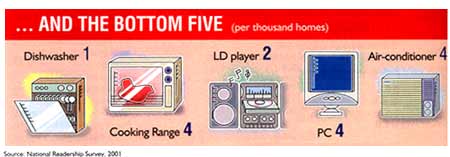|
 Has
the Indian consumer finally shaken off the yoke of ghulami in the
last decade? Yes and no. This decade has seen the most fundamental
change for Indian consumers. This change has its genesis in the
1991 economic crisis. If this crisis had not occurred, would we
have been pushed into opening up India both internally and to global
markets? The consumer revolution that we participate in and take
for granted was difficult to envision prior to this period. We have
swum with the tide and become the new Indian consumer without fully
comprehending this new-found azaadi. Has
the Indian consumer finally shaken off the yoke of ghulami in the
last decade? Yes and no. This decade has seen the most fundamental
change for Indian consumers. This change has its genesis in the
1991 economic crisis. If this crisis had not occurred, would we
have been pushed into opening up India both internally and to global
markets? The consumer revolution that we participate in and take
for granted was difficult to envision prior to this period. We have
swum with the tide and become the new Indian consumer without fully
comprehending this new-found azaadi.
This is the marketing azaadi that many of us
had dreamt about. Freedom from the shackles of the Muddled State
that held us hostage to shoddy products, poor service, a decade-long
queue for two-wheelers, and holidays abroad to buy electronics and
Victoria's Secret. Years of living with the tyranny of monopolies
and consequently of no choice. Insular politics and an unholy nexus
of business and its benefactors held us back.
So what has changed? The Big Five, as I call
them, are:
The Consumer: It is trite to say that
the consumer is king-to this truism we need to add that the consumer
is now queen, princess, and prince as well. The consumer has changed
dramatically, both quantitatively and qualitatively. It is irrelevant
to argue that if the so-called middle class is 15 or 250 million
strong. The mistakes of quantification have seen the graveyards
of brands, their businesses, and the aspirations of people who have
been pink slipped.
Today, the car is aspirational, not the two-wheeler;
own homes are, not rented acco. Rural consumers lap up urban products
and relate to the global village, delivered home through cable and
satellite feeds, blurring the neat categorisation of consumer segments.
Brands: Brands have thrived and products
have been commoditised. Differentiation on the product-dimension
is no longer anyone's preserve. Service remains a differentiator,
but that too is gradually getting commoditised. Witness the response-imagery
driven advertising targeting altered psychographics and consumer
aspirations. The Denim man does not need to try too hard. The Pepsi
generation is wedded to irreverent fun. Product (including service)
quality is a prerequisite; packaging is a critical marketing P.
Distribution is a differentiator, but is vanishing quickly. Pricing,
and margins, are only going one way-down. The positioning era has
truly arrived.
Technology: We are no longer in awe
of technology. We demand and dominate it. From 'low tech' soap-making
to 'hi-tech' pcs@home, we demand quality, at lower prices, and at
service levels that make many western marketers squirm. The Indian
market has seen the arrival of world-class products. Refrigerators
in real terms are almost at the same price as a decade ago. PCs
cost less each year. We can call (and thankfully receive calls too)
almost anywhere in the world from our six-year-old mobile services
at lower costs. More for less.
Global Integration: Does anyone remember
the 'Lehar' in Pepsi? Or that Lifebuoy, the great Indian brand,
is actually an international one. Or that ColorPlus, Amul, and Oberoi
are very Indian brands, with a taste of India, and we love them?
Or that Maruti is still technically a PSU?
As global consumers we do not care anymore
about the origins and lineage of the product as long as they satisfy
our needs as consumers. Who needs to shop in Singapore?
Passing of the Muddled State: An odd
entry in my big five is how finally we can enter (though less easily
exit) most segments of the Indian economy, build brands, et. al.
without having to rush to an insular and often apathetic Indian
State. I remember well how the Muddled State would react in the
1970s and 1980s if licensed capacities were increased to feed the
Indian consumer demands of more soap, cosmetics, or even cars.
How could Indian marketing have thrived in
such times? So, does that mean we have truly reached the nirvanic
consumerist state abhorred by some but loved by middle class India?
When we do finally succeed in enlarging the base of the Indian consumers
quantitatively, as policy-makers, change agents and marketing professionals,
the answer will be yes. That is yet to happen.
Till then, true azaadi will have to
wait.
Psychographic Profiles
Of Indian Consumers, Circa 2001 |
| WOMAN |
MAN |
| RELATIONSHIP |
RELATIONSHIP |
With Family: Relaxed, accommodative
and democratic
With Peer Group: Friendly but competitive
With Opposite Sex: Open but maintains a degree of rigidity
Self-Esteem: Moving towards the individualistic
Ambition: Sets high standards for children; high-to-moderate
ambitions for self husband
|
With Family: Flexible, but
still the breadwinner
With Peer Group: Open; but male bonding is on the wane
With Opposite Sex: More open but sticks to traditions
Self-Esteem: Very high; newer avenues within the family
Ambition: Very high for children; high for self; low
for wife |
| ATTITUDE |
ATTITUDE |
Towards Spouse: Democratic;
and seeking parity
Children: Nurturing; more of a friend
Fashion: High awareness but adopts selectively
Education: Paramount for children; more so for the daughter
Environment: Aware, but still indifferent |
Towards Spouse: Subjugation
to partnership
Children: More guiding than controlling
Fashion: Medium awareness but slow adoption
Education: Paramount for children; more so for the daughter
Environment: Aware, but not concerned |
| ROLE MODEL |
ROLE MODEL |
| Telly personalities. Her mother |
Professionally-successful men. |
|
 |
 |
|

